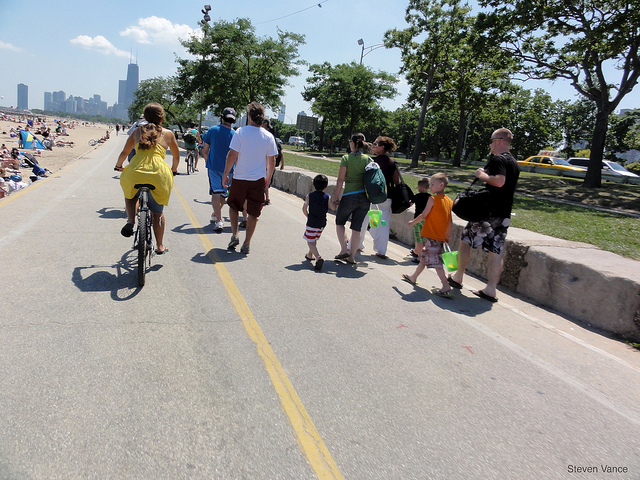Basic Etiquette Would Make The Lakefront Trail Safer
By Chuck Sudo in News on Dec 11, 2014 10:30PM

This photo by Steven Vance shows the hazards encountered at certain points along the lakefront trail on an average day.
Take the time to see how many people use the lakefront trail at any of its five busiest points and one comes to the conclusion it’s one of the most congested throughways in Chicago. An average of 30,000 people use the multipurpose path at its busiest sections daily, a number that soars to as many as 70,000 people on a summer weekend day.
With all those walkers, joggers, bicyclists, beachcombers, parents with strollers and others using the trail and crossing its lanes without a moment’s hesitation, it’s surprising the number of accidents on the lakefront trail isn’t larger than reported. (It’s also why we and other bicyclists would rather take our chances on the streets.)
But there is a growing call to separate cyclists from pedestrians and others on the lakefront trail. The Active Transportation Alliance launched a petition drive calling for the Park District to improve safety along the lakefront trail, including possibly separating cyclists from pedestrians wherever possible along the path.
Runner Megan Williams was training on the trail in September for the Chicago Marathon when she was involved in an accident with a cyclist; she woke up in the hospital.
"I'm really scared that if I go back, all of the emotions are going to come back," she said. "I still don't remember the accident. I don't know if it's buried somewhere deep down in my brain. I have a feeling as soon as I get on it I'll have a rush of emotions or a flashback."
Other safety measures Active Trans suggests in their petition include improving access points to the trail to accommodate all people including those with disabilities, seniors and children; to mark detours during construction along the path and remove debris as soon as possible; to limit the number of public events that use segments of the trail (the annual L.A.T.E. Ride is an example); and to begin a public education campaign alerting those using the trail to the dangers inherent using it and basic trail etiquette.
That last item is worth repeating: basic trail etiquette. It’s often sorely lacking on the lakefront trail. There’s a basic rule when using the path: since cyclists, runners and pedestrians all use it, all are considered traffic. Ergo, slower traffic stays to the right. Pedestrians yield to joggers who yield to cyclists. No one walks, runs or bikes abreast—always travel single file. Don't run or bike with earbuds in your ears. It's equivalent to running or biking deaf; you want your wits (and all your senses) about you to help avoid an accident. And you cyclists who use the trail as a personal time trial need to slow. The. Fuck. Down. This isn't the Tour de France and if you happen to reach the South Shore Cultural Center a few seconds slower, so be it.
If you asked those using the trail about basic etiquette they would a) likely not be able to tell you the rules of the trail and b) blame everyone else but themselves for making the trail dangerous. This problem will eventually raise its head once The 606 (aka The Bloomingdale Trail and another multipurpose path) opens to the public next year.
Public education and awareness is critical, much as it is when cyclists and motorists share the streets. We’re all subject to the same rules of the road on the streets and we’re all required to follow the rules of the lakefront trail when we use it. That photo above is not the exception to the everyday experience on the lakefront trail; it’s the rule, one that should be easy to change if everyone cooperates.